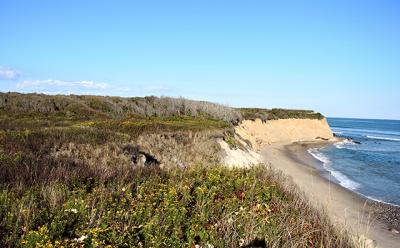Nature Notes: For Rich and Poor Alike

Some people say that we on the South Fork are going to hell in a handbasket. We look across the Peconics and see mostly green fields of grapes, vegetables, and other produce. Here most of the farmland is up for grabs, but thankfully that wonderful organization, the Peconic Land Trust, is out there grabbing. It is not only keeping viable farmland in production, it is revitalizing farm plots that have long stood dormant and recruiting young farmers, mostly the sons and daughters of old farmers, to make the land fertile once more. In a way, it’s the same way with fishermen.
In the old days men and women did both on the East End, fished and farmed. Then in the early 1900s, big money started to come to town, but that money belonged to a few of the noble rich. Nowadays, the money is mostly put up by the ignoble rich. Each generation tries to outdo the last, and, as a result, houses continue to become bigger and more pompous. As if overnight, truck farms are turned into ornate lawns with specimen trees. Hedges get even taller and thicker. The nouveau riche, as often as not, rent out these McMansions for the summer for as much as one could use to buy a decent-sized family house in the’70s or ’80s.
Fortunately, the county and the five eastern towns responded in their unique ways. Using zoning, which came into play in the ’60s, they began saving this and that parcel, this and that farmland and habitat, first without the benefit of the Peconic Bay Region Community Preservation Fund. Gifts to the Nature Conservancy and Peconic Land Trust and Suffolk County and New York State’s contributions of extra dollars for farmland and natural open spaces purchases were finally and graciously buoyed up by the addition of C.P.F. funds. We owe a lot to those political leaders who enacted the legislation to gird these acquisitions on the federal, state, county, and local level. Fortunately, some of them, like our local state assemblyman and state senator, Fred W. Thiele Jr. and Kenneth P. LaValle, are still in there pitching. Bravo to all of the environmentalists and farming enthusiasts who urged these acquisitions on at every level.
What we are left with as the East End builds out and the size of potential subdivisions dwindles from hundreds of acres of raw land to less than 10 acres, are wonderful family farms and wonderful patches of natural lands and scenic landscapes. Just think, the oak-holly-beech forest that comprised Hither Woods with all its little niches, is now in permanent open space status. More than 170 acres of Culloden, or “North Neck,” in Montauk is saved, and more than 700 acres of the Montauk moorlands’ low heath habitat rare to New York State, with its sandplain gerardia and numerous other rare plants, is safe for years to come.
Thanks to Concerned Citizens of Montauk, and the feds, state, county, and town, at least half of Montauk’s downs — now the largest prairie on Long Island in the absence of the over-developed Hempstead Plains, and, perhaps, the largest in New York State — has been spared the developers’ bulldozers for generations to come.
And, oh yes, in the ’90s the state acquired the land south of the highway and east of Camp Hero in Montauk, given the moniker the Sanctuary by the would-be developers. It is the site of the New York State Point Woods, perhaps the richest woodland on Long Island in terms of species. In 1923, Norman Taylor of the Brooklyn Botanic Gardens described the diversity there and now it is safe from development forever.
The Grace Estate, Barcelona, Northwest Woods, and Cedar Point County Park could have all been developed, but they are largely intact except for the camping grounds of the latter. Much of Wainscott’s pitch pine and oak forest is now in permanent open space, as is at least 50 percent of the unique white pine and pitch pine forest in East Hampton’s Northwest. Much of Napeague’s pitch pine forest, coastal dunes, and the one and only dune plain in the state, south of Cranberry Hole Road, is protected from development one way or another.
East Hampton Town in 1984, followed by East Hampton Village, then Southampton Town, passed a law protecting all wetlands, coastal bluffs, and dunes. East Hampton’s ordinance protects every wetland, even one as small as your living room, from destruction and ruin, thus greatly bolstering the state’s freshwater and tidal wetland laws enacted in 1973 and 1974, respectively.
As far as East Hampton goes, it all started in 1926 when the state, under the newly created Long Island State Park Commission led by Robert Moses, created the park that now includes Atlantic Ocean beach, coastal dunes, Hither Woods, and the Walking Dunes — 1,750 acres large. For the South Fork a major push for preservation got under way in Montauk. No wonder that the hamlet of Montauk has more parkland per acre than any other political subdivision on Long Island save, perhaps, for Brookhaven Town, in which most of the protected pine barrens forest is situated.
I grew up on the North Fork, where I toiled and gloried in the acres and acres of fertile farmland, but there were very few woodlands, heathlands, maritime grasslands, and other unique habitats and plant communities, which we have so many of on the South Fork.
There is still much to do. In the meantime I guess we will just have to hold our noses and look the other way as we drive by all of those new looming pretentious houses, knowing full well that the very soul of the best of the South Fork’s marvelous ecosystems have been set aside for both rich and poor alike to enjoy for generations to come.
Larry Penny can be reached via email at [email protected].
